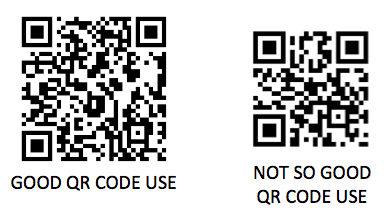In the last few days, I have encountered a spate of so-called nonprofit experts saying that QR codes are a bad idea for nonprofits. One went so far as to say that she would not include them in her book because they don’t work. That’s a sweeping statement and obviously there’s more that needs to be explained. What exactly doesn’t work? Or are the experts wrong and QR codes are a good idea? From my point-of-view, having seen the results firsthand and knowing what they can do and what they’re meant to do, my answer is QR codes are a good idea for nonprofits.
Let’s dissect the arguments one-by one.
You have to download a QR code reader and you need a smartphone
This one’s really a puzzling argument since 140 million people in the US have a smartphone per an August 2013 report from Comscore. There have been billions of apps downloaded to smartphones so the notion that smartphones are not prevalent and growing, and that downloading an app is somehow a foreign experience is an argument not supported by the data and the trends.
QR codes are supposed to be bad news for nonprofits because only a small portion of people scan them
Citing a report from 2011, (2011?-really! Mobile moves so fast that you really should cite current data. Blackberry probably thought they could survive back then. Now look at them.) only 6.2% of mobile device users have scanned a QR code.
Look at this graph from ScanLife and see the growth from 2011 to now. ScanLife also reported in the same report that this graph is from that 4 million people scanned a QR code for the first time in Q2/2013. This, they said, represents 22% growth from a year ago.
I’d hardly call these numbers small and certainly they are growing and once again the data refutes the “expert”.
QR code placement has been poor
Of course they have to be placed in locations with cell coverage and of course putting them on moving objects is a bad idea but is this the fault of the technology or the person using it? A recent report from NellyMoser suggests that QR codes in magazines have a better response rate than other forms of direct mail. Now I know most nonprofits can’t afford to put ads in magazines but this does point to the use of QR codes raising the odds of engagement. Especially since most of the scans are being done by the demographics many nonprofits are seeking to connect with to build for their future.
If I were a development director I would put QR codes on all my printed material and mention that the scan will take the user to a mobile-optimized destination. I would even go so far as to create unique QR codes for all my printed items and campaigns so I can see what message and placement works.
The end destination is not a mobile-optimized experience
Again, the QR code has nothing to do with this so why is the QR code a bad idea? I have always said all nonprofits need a great experience on mobile since the data says if you don’t, your supporters may disengage and they may give up their support for you. QR codes were created to get people to a mobile-optimized experience fast without having to type in a URL. This is a good experience not a bad one. The bad experience has nothing to do with the QR code; it’s the PC site on a mobile phone that’s the bad use of the QR code.
QR code awareness is small
Again, the data cited to make this claim is from 2011 and among younger demographics awareness is much higher. The graph above suggests both growth in awareness and usage. So this argument is dated and for that reason pretty much another lame argument not supported by current 3rd party data.
We’ve seen success
Some of our customers have used QR codes as part of a coordinated campaign which also leveraged other channels like email and social media. Most notably, they were part of a workplace giving campaign that saw a 10% YOY growth. The QR codes pointed to a mobile site on our platform (mobile-optimized of course) and they were and are a great way to get donors in the workplace to a donation page quickly on their own phone without having to use their employers PCs.
When thinking about using QR codes remember:
- Their use and awareness are growing
- Younger demographics skew higher in their use
- A mobile-optimized destination is mandatory
- QR code placement is easy, cheap and can be used to see what channels are really working in real-time
- They are a fast and easy way to get supporters and donors to your fundraising page
- They work well for workplace giving
I used to think that QR codes were frankly, dumb. Not anymore. In our multi-channel world of engagement, QR codes aren’t bad. They’re good.








